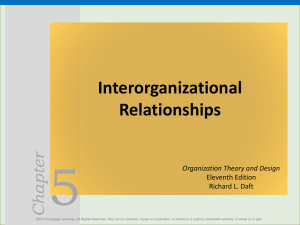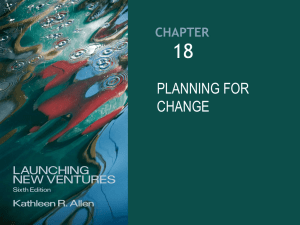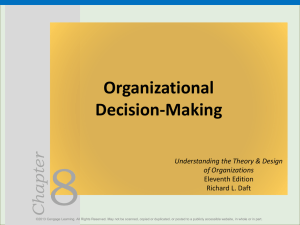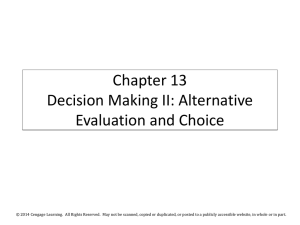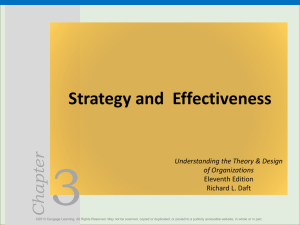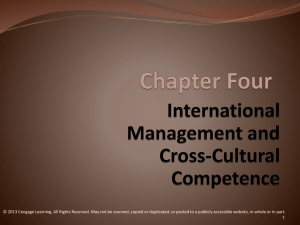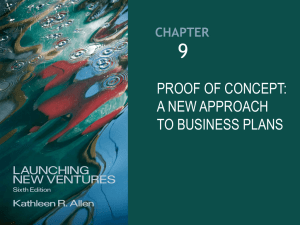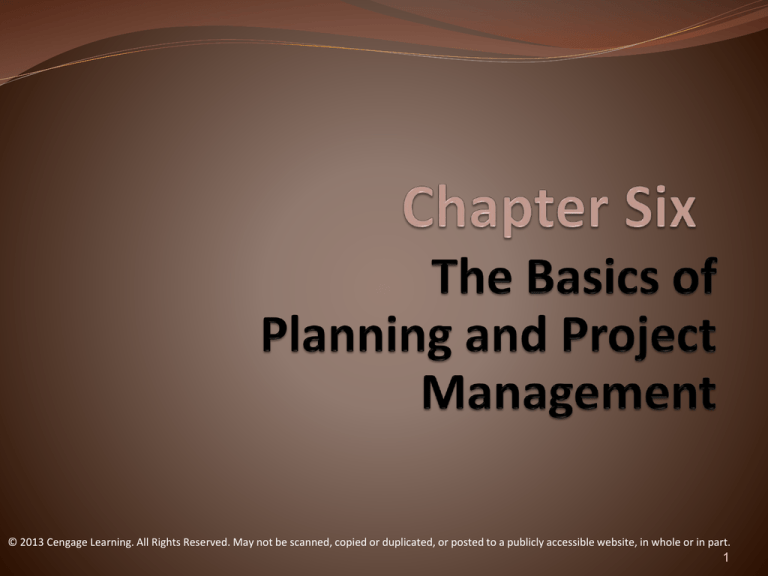
© 2013 Cengage Learning. All Rights Reserved. May not be scanned, copied or duplicated, or posted to a publicly accessible website, in whole or in part.
1
Chapter Objectives
Distinguish among state, effect, and response uncertainty.
Identify and define three types of planning.
Write good objectives and discuss the role of objectives in planning.
Describe the four-step management by objectives (MBO) process and
explain how it can foster individual commitment and motivation.
Discuss project planning within the context of the project life cycle and
list six roles played by project managers.
Compare and contrast flow charts and Gantt charts, and discuss the
value of PERT networks.
Explain how break-even points can be calculated.
© 2013 Cengage Learning. All Rights Reserved. May not be scanned, copied or duplicated, or posted to a publicly accessible website, in whole or in part.
2
Coping with Uncertainty
Planning
Coping with uncertainty by formulating courses of
action to achieve specified results
Three Types of Uncertainty
•
•
•
State uncertainty: Occurs when the environment, or a portion of
the environment, is considered unstable
Effect uncertainty: Occurs when impacts of environmental change
are unpredictable
Response uncertainty: Arises when the consequences of decisions
are unpredictable
© 2013 Cengage Learning. All Rights Reserved. May not be scanned, copied or duplicated, or posted to a publicly accessible website, in whole or in part.
3
Figure 6.1: Planning: The
Primary Management Function
© 2013 Cengage Learning. All Rights Reserved. May not be scanned, copied or duplicated, or posted to a publicly accessible website, in whole or in part.
4
Table 6.1: Uncertain Environment
© 2013 Cengage Learning. All Rights Reserved. May not be scanned, copied or duplicated, or posted to a publicly accessible website, in whole or in part.
5
The Essentials of Planning
A Plan:
Is a specific documented intention consisting of an
objective (end) and an action statement (means)
States what, when, and how something is to be done
Essentials of Sound Planning
Organizational mission
Types of planning
Objectives
Priorities
The planning/control cycle
© 2013 Cengage Learning. All Rights Reserved. May not be scanned, copied or duplicated, or posted to a publicly accessible website, in whole or in part.
6
Organizational Mission
A clear, formally written, and publicized statement
that guides the organization by:
Defining the organization for key stakeholders
Creating an inspiring vision of the organization
Outlining how the vision will be accomplished
Establishing key priorities
Stating a common goal and fostering togetherness
Creating a philosophical anchor for the organization
Generating enthusiasm and a “can do” attitude
Empowering organization members
© 2013 Cengage Learning. All Rights Reserved. May not be scanned, copied or duplicated, or posted to a publicly accessible website, in whole or in part.
7
Types of Planning
Strategic planning: Determining how to pursue long-
term goals with available resources
Intermediate planning: Determining subunits’
contribution with allocated resources
Operational planning: Determining how to
accomplish specific tasks with available resources
© 2013 Cengage Learning. All Rights Reserved. May not be scanned, copied or duplicated, or posted to a publicly accessible website, in whole or in part.
8
Planning Horizon
The elapsed time between the formulation and the
execution of a planned activity
Planning horizon length corresponds to the type of
plan with which it is associated; lengths shorten as the
planning process evolves from strategic to intermediate
to operational plans.
© 2013 Cengage Learning. All Rights Reserved. May not be scanned, copied or duplicated, or posted to a publicly accessible website, in whole or in part.
9
Objectives
An objective is a commitment to achieve a measurable
result within a specified period.
Writing Good Objectives
Objectives should be expressed in quantitative,
measurable, and concrete terms.
What specific result is to be achieved?
When is the result to be achieved?
How is the result to be measured?
Who will be responsible for achieving the result?
© 2013 Cengage Learning. All Rights Reserved. May not be scanned, copied or duplicated, or posted to a publicly accessible website, in whole or in part.
10
Objectives
(cont’d)
The Importance of Objectives (Uses of)
Target: Sets specific goals to achieve
Measuring stick: Gauges how much was achieved
Commitment: Encourages pursuit of the objective
Motivation: Provides a challenge for achievement
The Means-Ends Chain of Objectives
Achievement of lower-level objectives creates a means
for achieving higher-level objectives.
© 2013 Cengage Learning. All Rights Reserved. May not be scanned, copied or duplicated, or posted to a publicly accessible website, in whole or in part.
11
Priorities
Priorities are a ranking of goals, objectives, or activities
in order of importance to guide the order and timing
of decisions.
Management looks at its priorities when deciding how
to allocate resources.
© 2013 Cengage Learning. All Rights Reserved. May not be scanned, copied or duplicated, or posted to a publicly accessible website, in whole or in part.
12
Priorities
(cont’d)
The A-B-C Priority System
A: “Must do” objectives are critical to successful
performance.
B: “Should do” objectives are necessary for improved
performance.
C: “Nice to do” objectives are desirable for improved
performance but not critical to improved performance.
The 80/20 Principle (Pareto Analysis)
A majority of causes, inputs, or effort tends to produce
a majority of results, outputs, or rewards.
Avoid the “busyness” trap
© 2013 Cengage Learning. All Rights Reserved. May not be scanned, copied or duplicated, or posted to a publicly accessible website, in whole or in part.
13
Management by
Objectives and Project Planning
Management by Objectives (Peter Drucker)
A comprehensive management system based on
measurable, participatively set objectives
The MBO Cycle
Step 1: Setting objectives
Step 2: Developing action plans
Step 3: Periodic review
Step 4: Performance appraisal
© 2013 Cengage Learning. All Rights Reserved. May not be scanned, copied or duplicated, or posted to a publicly accessible website, in whole or in part.
14
Figure
6.6: The
Project
Life Cycle
and
Project
Planning
Activities
© 2013 Cengage Learning. All
Rights Reserved. May not be
scanned, copied or duplicated,
or posted to a publicly
accessible website, in whole or
in part.
15
Graphic
Planning/Scheduling/Control Tools
Flow Charts
Gantt Charts
PERT Networks
© 2013 Cengage Learning. All Rights Reserved. May not be scanned, copied or duplicated, or posted to a publicly accessible website, in whole or in part.
16
Break-Even Analysis
Break-Even Point
The level of sales at which there is no loss or profit
The point at which the total of fixed and variable costs
is equal to total sales revenues
Fixed Versus Variable Costs
Fixed costs: Contractual costs that must be paid
regardless of output or sales
Variable costs: Costs that vary directly with production
and sales
© 2013 Cengage Learning. All Rights Reserved. May not be scanned, copied or duplicated, or posted to a publicly accessible website, in whole or in part.
17
Summary
Planning is the primary management function.
A properly written plan tells what, when, and how something is to be
accomplished.
Objectives are the single most important feature of the planning
process.
Management by objectives (MBO) is based on measurable and
participatively set goals.
Project planning occurs throughout the project life cycle.
Flow charts, Gantt charts, and PERT networks are graphical tolls for
planning, scheduling, and controlling operations.
Break-even analysis gauges the impact of price changes and profit
objectives on sales volume.
© 2013 Cengage Learning. All Rights Reserved. May not be scanned, copied or duplicated, or posted to a publicly accessible website, in whole or in part.
18
Terms to Understand
Planning
State uncertainty
Effect uncertainty
Response uncertainty
Plan
Strategic planning
Intermediate planning
Operational planning
Planning horizon
Objective
Priorities
80/20 principle
Management by objectives
(MBO)
Project
Gantt chart
Program Evaluation and Review
Technique (PERT)
PERT event
PERT activity
PERT times
Critical path
Break-even analysis
Fixed costs
Variable costs
Contribution margin
© 2013 Cengage Learning. All Rights Reserved. May not be scanned, copied or duplicated, or posted to a publicly accessible website, in whole or in part.
19




